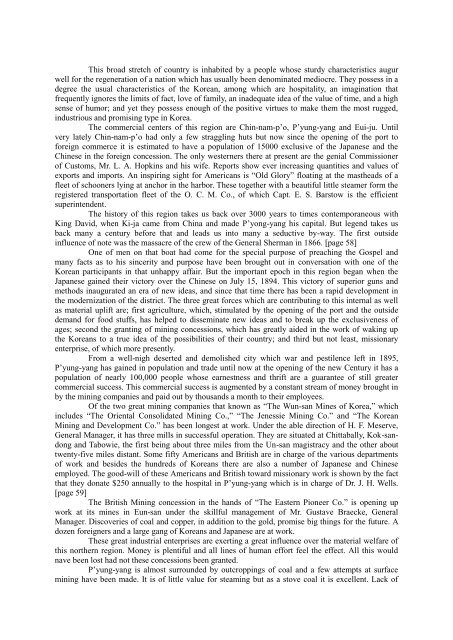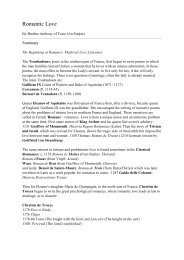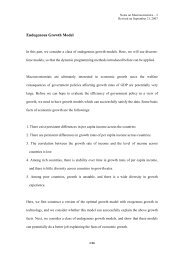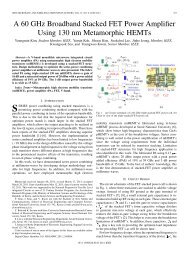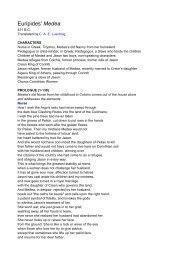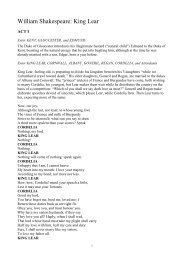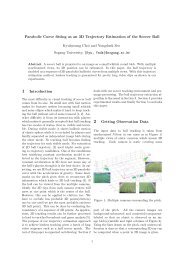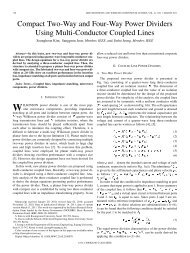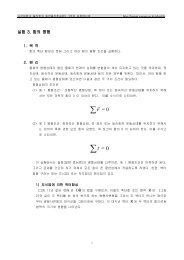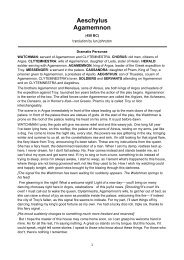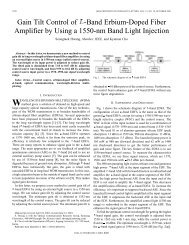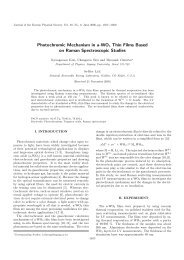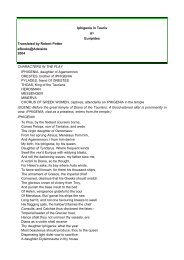THE KOREA REVIEW Volume 1, 1901 Homer B. Hulbert A.M. ...
THE KOREA REVIEW Volume 1, 1901 Homer B. Hulbert A.M. ...
THE KOREA REVIEW Volume 1, 1901 Homer B. Hulbert A.M. ...
You also want an ePaper? Increase the reach of your titles
YUMPU automatically turns print PDFs into web optimized ePapers that Google loves.
This broad stretch of country is inhabited by a people whose sturdy characteristics augur<br />
well for the regeneration of a nation which has usually been denominated mediocre. They possess in a<br />
degree the usual characteristics of the Korean, among which are hospitality, an imagination that<br />
frequently ignores the limits of fact, love of family, an inadequate idea of the value of time, and a high<br />
sense of humor; and yet they possess enough of the positive virtues to make them the most rugged,<br />
industrious and promising type in Korea.<br />
The commercial centers of this region are Chin-nam-p’o, P’yung-yang and Eui-ju. Until<br />
very lately Chin-nam-p’o had only a few straggling huts but now since the opening of the port to<br />
foreign commerce it is estimated to have a population of 15000 exclusive of the Japanese and the<br />
Chinese in the foreign concession. The only westerners there at present are the genial Commissioner<br />
of Customs, Mr. L. A. Hopkins and his wife. Reports show ever increasing quantities and values of<br />
exports and imports. An inspiring sight for Americans is “Old Glory” floating at the mastheads of a<br />
fleet of schooners lying at anchor in the harbor. These together with a beautiful little steamer form the<br />
registered transportation fleet of the O. C. M. Co., of which Capt. E. S. Barstow is the efficient<br />
superintendent.<br />
The history of this region takes us back over 3000 years to times contemporaneous with<br />
King David, when Ki-ja came from China and made P’yong-yang his capital. But legend takes us<br />
back many a century before that and leads us into many a seductive by-way. The first outside<br />
influence of note was the massacre of the crew of the General Sherman in 1866. [page 58]<br />
One of men on that boat had come for the special purpose of preaching the Gospel and<br />
many facts as to his sincerity and purpose have been brought out in conversation with one of the<br />
Korean participants in that unhappy affair. But the important epoch in this region began when the<br />
Japanese gained their victory over the Chinese on July 15, 1894. This victory of superior guns and<br />
methods inaugurated an era of new ideas, and since that time there has been a rapid development in<br />
the modernization of the district. The three great forces which are contributing to this internal as well<br />
as material uplift are; first agriculture, which, stimulated by the opening of the port and the outside<br />
demand for food stuffs, has helped to disseminate new ideas and to break up the exclusiveness of<br />
ages; second the granting of mining concessions, which has greatly aided in the work of waking up<br />
the Koreans to a true idea of the possibilities of their country; and third but not least, missionary<br />
enterprise, of which more presently.<br />
From a well-nigh deserted and demolished city which war and pestilence left in 1895,<br />
P’yung-yang has gained in population and trade until now at the opening of the new Century it has a<br />
population of nearly 100,000 people whose earnestness and thrift are a guarantee of still greater<br />
commercial success. This commercial success is augmented by a constant stream of money brought in<br />
by the mining companies and paid out by thousands a month to their employees.<br />
Of the two great mining companies that known as “The Wun-san Mines of Korea,” which<br />
includes “The Oriental Consolidated Mining Co.,” “The Jenessie Mining Co.” and “The Korean<br />
Mining and Development Co.” has been longest at work. Under the able direction of H. F. Meserve,<br />
General Manager, it has three mills in successful operation. They are situated at Chittabally, Kok-sandong<br />
and Tabowie, the first being about three miles from the Un-san magistracy and the other about<br />
twenty-five miles distant. Some fifty Americans and British are in charge of the various departments<br />
of work and besides the hundreds of Koreans there are also a number of Japanese and Chinese<br />
employed. The good-will of these Americans and British toward missionary work is shown by the fact<br />
that they donate $250 annually to the hospital in P’yung-yang which is in charge of Dr. J. H. Wells.<br />
[page 59]<br />
The British Mining concession in the hands of “The Eastern Pioneer Co.” is opening up<br />
work at its mines in Eun-san under the skillful management of Mr. Gustave Braecke, General<br />
Manager. Discoveries of coal and copper, in addition to the gold, promise big things for the future. A<br />
dozen foreigners and a large gang of Koreans and Japanese are at work.<br />
These great industrial enterprises are exerting a great influence over the material welfare of<br />
this northern region. Money is plentiful and all lines of human effort feel the effect. All this would<br />
nave been lost had not these concessions been granted.<br />
P’yung-yang is almost surrounded by outcroppings of coal and a few attempts at surface<br />
mining have been made. It is of little value for steaming but as a stove coal it is excellent. Lack of


